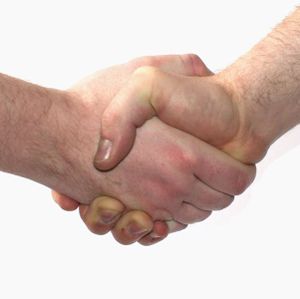Handshake
A handshake is a short ritual in which two people grasp one of each other's like hands, in most cases accompanied by a brief up and down movement of the grasped hands.
Modern customs
The handshake is initiated when the two hands touch, immediately. It is commonly done upon meeting, greeting, parting, offering congratulations, expressing gratitude, or completing an agreement. In sports or other competitive activities, it is also done as a sign of good sportsmanship. Its purpose is to convey trust, balance, and equality.
Unless health issues or local customs dictate otherwise a handshake should always be made using bare hands. In some regions especially in Continental Europe, attempting to perform a handshake while wearing gloves may be seen as an inappropriate or even derogatory behavior. In traditional American etiquette the requirement to remove a glove depends on the situation - "A gentleman on the street never shakes hands with a lady without first removing his right glove. But at the opera, or at a ball, or if he is usher at a wedding, he keeps his glove on."
- In Anglophone countries, in business situations. In casual non-business situations, men are more likely to shake hands than women. It is considered to be in poor taste to show dominance with too strong a handshake; conversely, too weak a handshake (sometimes referred to as a "limp fish" or "dead fish" handshake) could also be considered unseemly due to people perceiving it as a sign of weakness.
- In Continental European countries, people shake hands almost every time upon meeting in business situations and also in casual non-business situations.
- In Belgium, it is expected that everyone in the group shake hands upon meeting and also when leaving a meeting.
- In Switzerland, it is expected to shake the women’s hands first. Otherwise, shaking hands in order of rank is regarded as appropriate.
In some religions, such as Orthodox Judaism and Islam (according to some opinions), the prohibition against physical contact between members of opposite sexes precludes shaking hands. In these religions, men and women however do shake hands amongst people of the same gender. Between opposite genders, a short nod or bow is given. Moroccans also give one kiss on each cheek (to corresponding genders) together with the handshake. Also, in some countries, a variation exists where instead of kisses, after the handshake the handpalm is placed unto the heart.
In the Muslim World, to shake hands with somebody is a welcome sign and the practice of the Prophet Mohammed. The social behavior of the Companions also included handshaking along with saying, "As-Salamu `Alaikum." This Hadith by Abu Dawud shows that the custom of handshaking was prevalent in Yemen before Islam. When some Yemenites came to see the Prophet, they displayed their practice of handshake. He approved of it and made it a part of his sunnah. In some Muslim countries (such as Turkey or the Arabic-speaking Middle East), handshakes aren't as firm as in North America and Europe. Consequently, a grip which is too firm will be considered as rude. In Turkey, outside business situations, shaking hands is not the standard greeting among men. In casual non-business situations, men will less likely shake hands and among women hardly at all. Kissing each other on the cheek twice is a more common practice.
- In Sudan, people who know each other a good pat on the shoulder of the other before shaking hands.
- In China, where a weak handshake is also preferred, people shaking hands will often hold on to each other's hands for an extended period after the initial handshake.
- In Japan, it is appropriate to let the Japanese initiate the handshake, and a weak handshake is preferred.
- In South Korea, a senior person will initiate a handshake, where it is preferred to be weak. It is a sign of respect to grasp the right arm with the left hand when shaking hands.
Types of handshakes:
- Hand Hug: The "handhug" is popular with politicians, as it can present them as being warm, friendly, trustworthy and honest. This type of handshake involves covering the clenched hands with the remaining free hand, creating a sort of "cocoon."
- Dominance: Someone who displays their palm upwards is considered to show signs of authority or superiority.
- Cold and Clammy: Occurs when one person has a sweaty or cold hand. Sometimes associated with weakness - such as by passive or apathetic people.
- Crusher: Considered the favorite of those who are overly aggressive, this displays confidence and power and can be quite painful for the recipient.
- Queens Fingertips: Common in male-female encounters, it involves one person (usually the female) presenting an outstretched hand in which only the first few digits can be grasped.
- Keep Back: This handshake occurs when one party may feel threatened or intruded upon, and will keep at a (relative) distance during the handshake.
- More information is available at [ Wikipedia:Handshake ]
Chat rooms • What links here • Copyright info • Contact information • Category:Root
